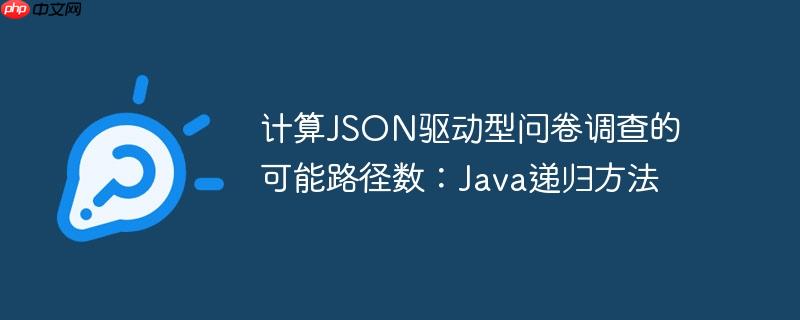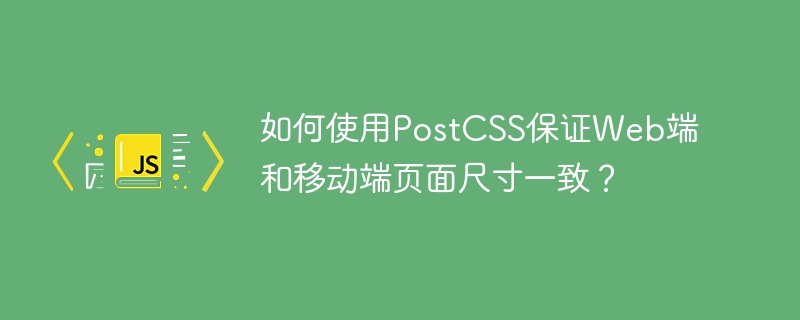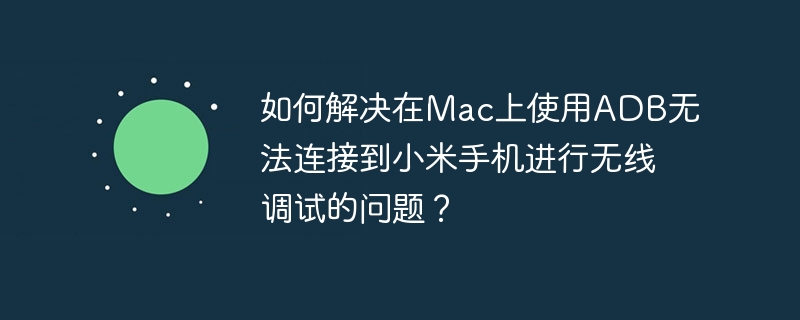
本文介绍如何使用Java和递归算法来计算基于json配置的问卷调查中所有可能的路径数量。我们将详细解释如何解析JSON结构,并使用递归函数遍历问卷调查的每个分支,最终计算出所有可能的完成路径。此外,还会讨论这种方法的一些优点和局限性,并提供优化建议。
理解JSON结构
首先,我们需要理解JSON配置的结构。 问卷调查的JSON配置定义了问题之间的依赖关系。每个问题都映射到一组可能的答案,每个答案又指向下一个问题。 如果答案指向以 “0” 开头的字符串,则表示问卷调查已结束。
例如:
{ "What is your marital status?": { "Single": "Are you planning on getting married next year?", "Married": "How long have you been married?" }, "Are you planning on getting married next year?": { "Yes": "0 Thanks for your answers! We hope that you will build a cool family!", "No": "0 Thanks for your answers! Who knows, maybe you'll find someone significant in your life!" }, "How long have you been married?": { "Less than a year": "0 Thanks for your answers! We hope that you will celebrate your one year anniversary soon!", "More than a year": "Have you celebrated your one year anniversary?" }, "Have you celebrated your one year anniversary?": { "Yes": "0 Wow, cool! Keep it up! Thanks for your answers.", "No": "0 We think you should fix it next time! Thanks for your answers!" } }
递归算法实现
我们可以使用递归算法来计算可能的路径数量。递归函数将遍历JSON结构,并对每个问题的所有可能答案进行计数。当遇到结束节点时,递归将返回1。
立即学习“Java免费学习笔记(深入)”;
以下是Java代码示例,使用Jackson库来解析JSON:
import com.fasterxml.jackson.databind.JsonNode; import com.fasterxml.jackson.databind.ObjectMapper; import java.io.IOException; import java.util.concurrent.atomic.AtomicInteger; public class QuizPathCounter { public static int countWays(JsonNode node, String question) { JsonNode answers = node.get(question); if (answers == NULL) { return 1; // End of path } AtomicInteger ways = new AtomicInteger(); answers.fields().forEachRemaining(answer -> ways.addAndGet(countWays(node, answer.getValue().asText()))); return ways.get(); } public static void main(String[] args) throws IOException { String jsonString = "{" + " "What is your marital status?": {" + " "Single": "Are you planning on getting married next year?"," + " "Married": "How long have you been married?"" + " }," + " "Are you planning on getting married next year?": {" + " "Yes": "0 Thanks for your answers! We hope that you will build a cool family!"," + " "No": "0 Thanks for your answers! Who knows, maybe you'll find someone significant in your life!"" + " }," + " "How long have you been married?": {" + " "Less than a year": "0 Thanks for your answers! We hope that you will celebrate your one year anniversary soon!"," + " "More than a year": "Have you celebrated your one year anniversary?"" + " }," + " "Have you celebrated your one year anniversary?": {" + " "Yes": "0 Wow, cool! Keep it up! Thanks for your answers."," + " "No": "0 We think you should fix it next time! Thanks for your answers!"" + " }" + "}"; ObjectMapper mapper = new ObjectMapper(); JsonNode node = mapper.readTree(jsonString); int numberOfPaths = countWays(node, "What is your marital status?"); System.out.println("Number of possible paths: " + numberOfPaths); // Output: 4 } }
代码解释:
-
countWays(JsonNode node, String question) 函数:
- 接受 JSON 节点 node 和当前问题 question 作为输入。
- 尝试获取当前问题的答案节点 answers。
- 如果 answers 为 null,则表示到达路径的终点,返回 1。
- 否则,使用 AtomicInteger 累加所有可能答案的路径数量。
- 对于每个答案,递归调用 countWays 函数,并将答案作为下一个问题。
- 返回所有答案路径的总数。
-
main 函数:
注意事项和优化
- Jackson库: 确保你已将Jackson库添加到你的项目中。你可以使用maven或gradle来管理依赖。
- 性能: 对于非常复杂的问卷调查,递归可能会导致堆栈溢出错误。 在这种情况下,可以考虑使用迭代方法。
- 错误处理: 在实际应用中,应添加错误处理代码来处理无效的JSON结构或意外的错误。
- 缓存: 对于相同的 JSON 结构,可以缓存结果以提高性能。
总结
本文介绍了如何使用Java和递归算法来计算基于JSON配置的问卷调查中所有可能的路径数量。这种方法简单易懂,适用于大多数情况。 但是,对于非常复杂的问卷调查,可能需要考虑使用迭代方法或缓存来提高性能。 重要的是要根据实际情况选择最合适的方法。
© 版权声明
文章版权归作者所有,未经允许请勿转载。
THE END


















